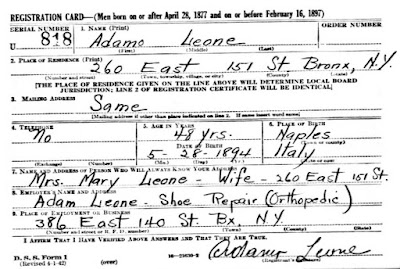 |
| Maria Rosa Caruso, my great grandmother |
Two months ago I wrote about how I'm downloading every vital record for my ancestral towns from an Italian genealogical archives web site.
Last night all that information came together to take me back two more generations on a branch of my family tree that hadn't grown in years.
Here's what happened.
I discovered many years ago that my great grandmother, Maria Rosa Caruso, was born in Pescolamazza, Italy. That was a problem at the outset because there is no such town! With a little research, I learned that Pescolamazza was renamed long ago to Pesco Sannita.
Pesco Sannita, in the province of Benevento, is a beautiful, well-manicured hill town that's very close to each of my other ancestral towns. (My heritage is highly concentrated!) I visited the town and its cemetery in 2005.
Over the last two days I downloaded every birth, marriage and death record for Pescolamazza from 1809 to 1942 (with a very big gap from 1861 to 1930). Once I had everything downloaded into sub-folders by year and type of document, I began searching for Maria Rosa Caruso's birth record and learned she had a twin brother Luca.
 |
| Maria Rosa's birth record. |
This record confirmed her mother's full name of Maria Luigia Girardi. So I searched for Maria Luigia's 1840 birth record and found it. Et voila! I had her parents' names: Gioacchino Girardi and Maria Teresa deNigris.
I also found her husband's 1842 birth record—that's my great great grandfather Francesco Saverio Caruso—and learned his parents' names: Giuseppe Caruso and Luigia Pennucci.
The 1814 birth records are not available for Gioacchino Girardi and Maria Teresa deNigris, so I went searching for their marriage documents. Bingo!
The set of 1840 marriage documents told me that Gioacchino's middle name was Napoleone (was that 1814 patriotism or fear I wonder) and his parents were Nicola Girardi and Maria Pennucci. Maria Teresa's parents were Pasquale deNigris and Maria Emanuele Inglese.
 |
| Key facts from an Italian marriage record. |
This generation of my 4x great grandparents was born between 1784 and 1793. I happily gained three new surnames (or cognomi in italiano): deNigris, Pennucci and Inglese.
I've expanded the families a bit more by finding two siblings for Maria Luigia Girardi and two for Francesco Saverio Caruso.
I will eventually squeeze every last drop of family out of these vital records as I did for my maternal grandfather's Italian hometown a few years ago.





